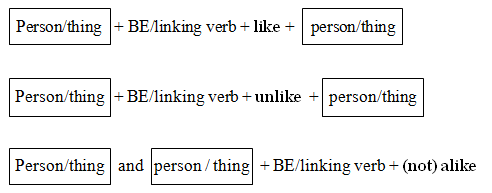5.1.4 การเปรียบเทียบคำคุณศัพท์
การเปรียบเทียบคำคุณศัพท์มีอยู่ 3 ขั้น คือ
|
1) การเปรียบเทียบขั้นธรรมดา (Positive Degree)
การเปรียบเทียบขั้นธรรมดา เป็นการเปรียบเทียบคน สิ่งของ สถานที่ ฯลฯ จำนวน 2 คน 2 อย่าง 2 สถานที่ ฯลฯ เช่น ถ้าเป็น คน จะเป็นการเปรียบเทียบ
คน 2 คน
คน 1 คน กับ คน 1 กลุ่ม
คน 1 กลุ่ม กับ คนอีก 1 กลุ่ม
การเปรียบเทียบขั้นธรรมดานี้เป็นการเปรียบเทียบคุณสมบัติที่เหมือนกันหรือเท่าเทียมกัน มีวิธีการเปรียบเทียบโดยใช้โครงสร้าง ดังนี้
![]() as + adjective/adverb + as
as + adjective/adverb + as
ประโยคบอกเล่าใช้ as … as เช่น
Sunan is as tall as Pranee.
This washing machine is as expensive as that one.
ประโยคปฏิเสธใช้ not as … as หรือ not so … as เช่น
Sunee is not as tall as Sunan and Pranee.
A bicycle is not so expensive as a motorcycle.
![]() ใช้ like/alike เพื่อบอกว่า ‘เหมือนกัน’ และใช้ unlike/not alike เพื่อบอกว่า ‘ไม่เหมือนกัน’ ซึ่งจะใช้กับฺ BE หรือ linking verb เช่น look, seem เป็นต้น
ใช้ like/alike เพื่อบอกว่า ‘เหมือนกัน’ และใช้ unlike/not alike เพื่อบอกว่า ‘ไม่เหมือนกัน’ ซึ่งจะใช้กับฺ BE หรือ linking verb เช่น look, seem เป็นต้น
Tom is very like his brother, Keith.
Tom and Keith are alike.
Like his father, John is 180 centimeters tall.
Unlike his brother, Pete is short and stout.
Although Mary and Jane are twins, they do not look alike. Mary has brown hair and big eyes, but Jane has black hair and small eyes.
จากตัวอย่าง การใช้ like, alike, unlike, not alike มีโครงสร้างดังนี้
like + noun/noun phrase

นอกจากนี้ ใช้คำและกลุ่มคำเหล่านี้ในการเปรียบเทียบได้ คือ similar/similar to และ the same/the same as ซึ่งมีความหมายว่า เหมือนกับ เช่นเดียวกับ เช่น
Our houses aresimilar in size and color.
My sisters look very similar.
His writing style is similar to that of yours.
Kanda and Susie are friends.They are both the same age. Susie is the same
age as Kanda.
I would like you to feel the same as if you were at home.
โครงสร้างประโยคในการใช้ similar/similar to และ the same as เป็นดังนี้
Plural Subject + BE/linking verb + similar
Subject + BE/linking verb + similar to + N/NP/PRON
Plural Subject +BE/linking verb + the same + N
Subject + BE/linking verb + the same as + N/NP/PRON
2) การเปรียบเทียบขั้นกว่า (Comparative Degree)
การเปรียบเทียบขั้นกว่าเป็นการเปรียบเทียบคน สิ่งของ หรือสถานที่ ฯลฯ จำนวน 2 คน 2 อย่าง หรือ 2 สถานที่ ฯลฯ ในทำนอง ‘น้อยกว่า/มากกว่า’ เช่น ถ้าเป็น คน จะเป็นการเปรียบเทียบ
คน 2 คน
คน 1 คน กับ คน 1 กลุ่ม
คน 1 กลุ่ม กับ คนอีก 1 กลุ่ม
เช่น The bicycle is slower than the motorcycle.
The motorcycle is faster than the bicycle.
Cars and motorcycles are faster than bicycles.
Gold is more expensive than silver.
Silver is less expensive than gold.
การเปรียบเทียบคำคุณศัพท์ขั้นกว่า
![]() ถ้าคำคุณศัพท์เป็นคำที่มีพยางค์เดียว ให้เติม -er ท้ายคำ
ถ้าคำคุณศัพท์เป็นคำที่มีพยางค์เดียว ให้เติม -er ท้ายคำ
![]() คำคุณศัพท์ที่มี 2 พยางค์ เป็นคำที่ลงท้ายด้วย -er, -le, -ow และ –y ส่วนมาก เช่น clever, simple, narrow, easy ให้เติม -er ท้ายคำ (คำที่ลงท้าย –y ต้อง
คำคุณศัพท์ที่มี 2 พยางค์ เป็นคำที่ลงท้ายด้วย -er, -le, -ow และ –y ส่วนมาก เช่น clever, simple, narrow, easy ให้เติม -er ท้ายคำ (คำที่ลงท้าย –y ต้อง
เปลี่ยน y เป็น i แล้วเติม -er)
![]() คำคุณศัพท์ที่มี 2 พยางค์นอกเหนือจากที่กล่าวในข้อ 2 และคำที่มีมากกว่า 2 พยางค์ ให้ใช้ more นำหน้าคำคุณศัพท์ เพื่อให้ความหมายว่า ‘มากกว่า’
คำคุณศัพท์ที่มี 2 พยางค์นอกเหนือจากที่กล่าวในข้อ 2 และคำที่มีมากกว่า 2 พยางค์ ให้ใช้ more นำหน้าคำคุณศัพท์ เพื่อให้ความหมายว่า ‘มากกว่า’
![]() คำคุณศัพท์ที่มี 2 พยางค์นอกเหนือจากที่กล่าวในข้อ 2 และคำที่มีมากกว่า 2 พยางค์ ให้ใช้ less นำหน้าคำคุณศัพท์ เพื่อให้ความหมายว่า ‘น้อยกว่า’
คำคุณศัพท์ที่มี 2 พยางค์นอกเหนือจากที่กล่าวในข้อ 2 และคำที่มีมากกว่า 2 พยางค์ ให้ใช้ less นำหน้าคำคุณศัพท์ เพื่อให้ความหมายว่า ‘น้อยกว่า’
![]() ในการเปรียบเทียบขั้นกว่า จะต้องใช้ than หลังคำคุณศัพท์ แล้วตามด้วยคำนามที่เป็นตัวเปรียบเทียบ
ในการเปรียบเทียบขั้นกว่า จะต้องใช้ than หลังคำคุณศัพท์ แล้วตามด้วยคำนามที่เป็นตัวเปรียบเทียบ
3) การเปรียบเทียบขั้นสุด (Superlative Degree)
การเปรียบเทียบขั้นสุดเป็นการเปรียบเทียบคน สิ่งของ หรือสถานที่ ฯลฯ ที่มีจำนวน 3 คน 3 อย่าง หรือ 3 สถานที่ ฯลฯ ขึ้นไป แสดงว่าคนหนึ่งคนใด สิ่งหนึ่งสิ่งใด ฯลฯ เป็นที่หนึ่งเดียวในกลุ่มคนหรือสิ่งของอย่างเดียวกันนั้น ฯลฯ
Of the five boys, John is the tallest.
His house is the largest in this village.
Julie is the most intelligent woman I have ever met.
Many people think that the visitor’s speech was the most boring one.
การเปรียบเทียบคำคุณศัพท์ขั้นที่สุด
![]() ถ้าคำคุณศัพท์เป็นคำที่มีพยางค์เดียว ให้เติม -est ท้ายคำ
ถ้าคำคุณศัพท์เป็นคำที่มีพยางค์เดียว ให้เติม -est ท้ายคำ
![]() คำคุณศัพท์มี 2 พยางค์ เป็นคำที่ลงท้ายด้วย -er, -le, -ow หรือ -y ส่วนมาก เช่น clever, simple, narrow, easy ให้เติม -est ท้ายคำ (คำที่ลงท้าย -y ต้องเปลี่ยน y เป็น i แล้วเติม -est)
คำคุณศัพท์มี 2 พยางค์ เป็นคำที่ลงท้ายด้วย -er, -le, -ow หรือ -y ส่วนมาก เช่น clever, simple, narrow, easy ให้เติม -est ท้ายคำ (คำที่ลงท้าย -y ต้องเปลี่ยน y เป็น i แล้วเติม -est)
![]() คำคุณศัพท์ที่มี 2 พยางค์นอกเหนือจากที่กล่าวแล้ว และคำที่มีมากกว่า 2 พยางค์ ให้ใช้ most นำหน้าคำคุณศัพท์เพื่อให้ความหมายว่า ‘มากที่สุด’
คำคุณศัพท์ที่มี 2 พยางค์นอกเหนือจากที่กล่าวแล้ว และคำที่มีมากกว่า 2 พยางค์ ให้ใช้ most นำหน้าคำคุณศัพท์เพื่อให้ความหมายว่า ‘มากที่สุด’
![]() คำคุณศัพท์ที่มี 2 พยางค์นอกเหนือจากที่กล่าวแล้ว และคำที่มีมากกว่า 2 พยางค์ ให้ใช้ least นำหน้าคำคุณศัพท์เพื่อให้ความหมายว่า ‘น้อยที่สุด’
คำคุณศัพท์ที่มี 2 พยางค์นอกเหนือจากที่กล่าวแล้ว และคำที่มีมากกว่า 2 พยางค์ ให้ใช้ least นำหน้าคำคุณศัพท์เพื่อให้ความหมายว่า ‘น้อยที่สุด’
![]() ในการเปรียบเทียบขั้นที่สุด จะต้องใช้ the นำหน้าคำคุณศัพท์ด้วย
ในการเปรียบเทียบขั้นที่สุด จะต้องใช้ the นำหน้าคำคุณศัพท์ด้วย
ตารางต่อไปนี้เป็นตัวอย่างแสดงการเปรียบเทียบคำคุณศัพท์
ขั้นธรรมดา (positive degree) |
ขั้นกว่า (comparative degree) |
ขั้นสุด (superlative degree) |
|
คำทีเติม -er และ -est |
long large busy easy simple clever etc. |
longer larger busier easier simpler cleverer |
longest largest busiest easiest simplest cleverest |
ขั้นธรรมดา (positive degree) |
ขั้นกว่า (comparative degree) |
ขั้นสุด (superlative degree) |
|
ใช้ more/less most/least |
careful pleasant boring etc. |
more careful more pleasant more boring |
most careful most pleasant most boring |
คำคุณศัพท์บางคำมีรูป comparative degree และ superlative degree เฉพาะ
ขั้นธรรมดา (positive degree) |
ขั้นกว่า (comparative degree) |
ขั้นสุด (superlative degree) |
||||||||||||
|
|
|